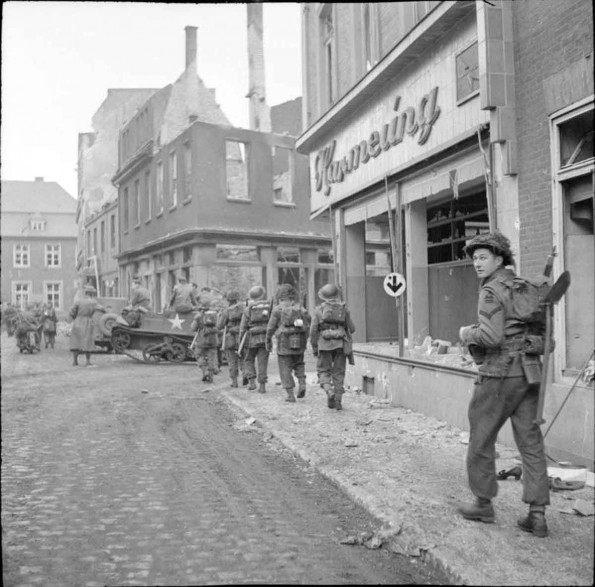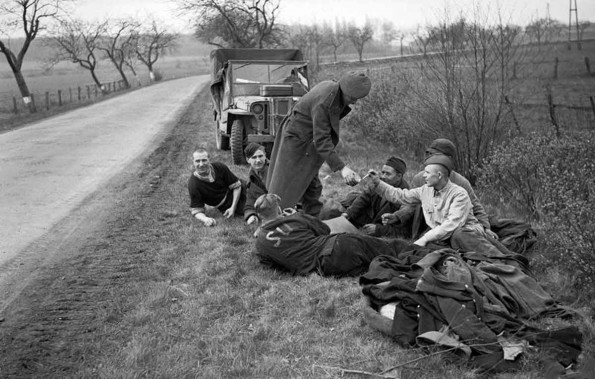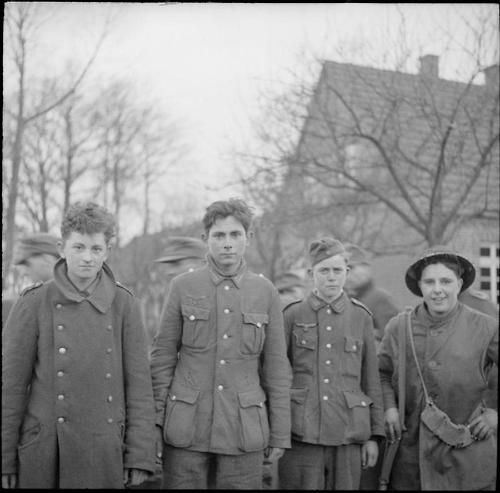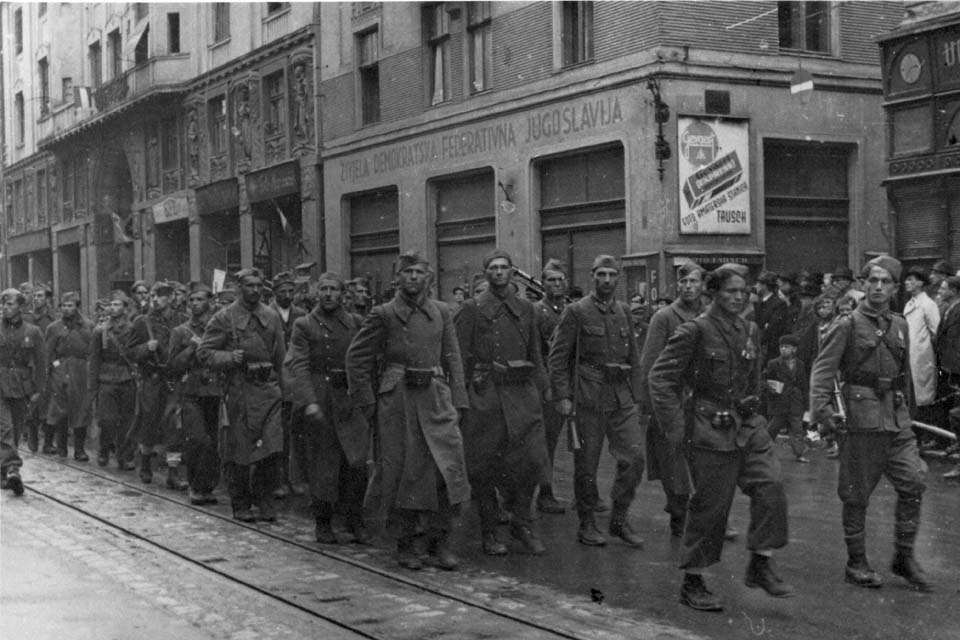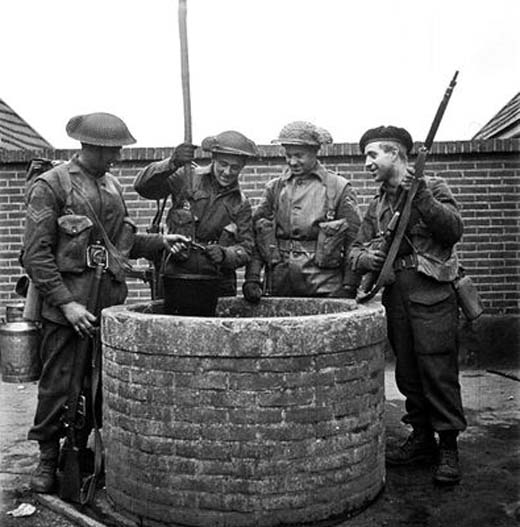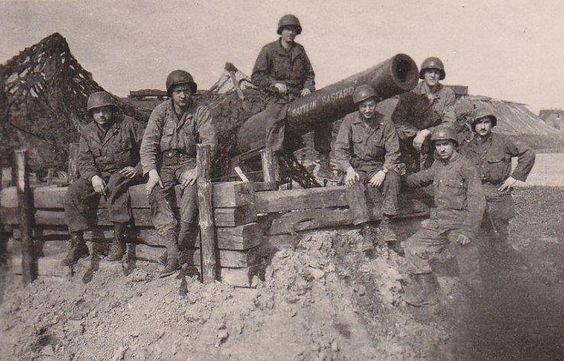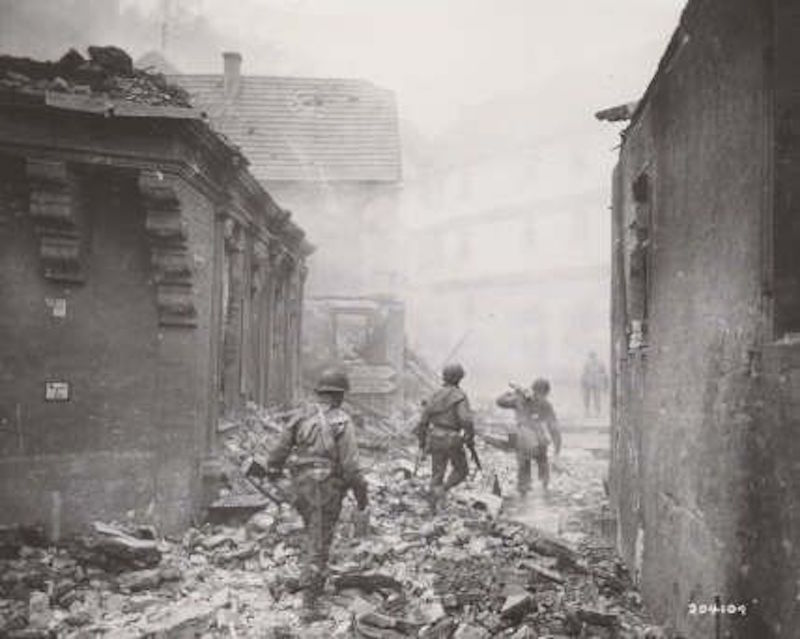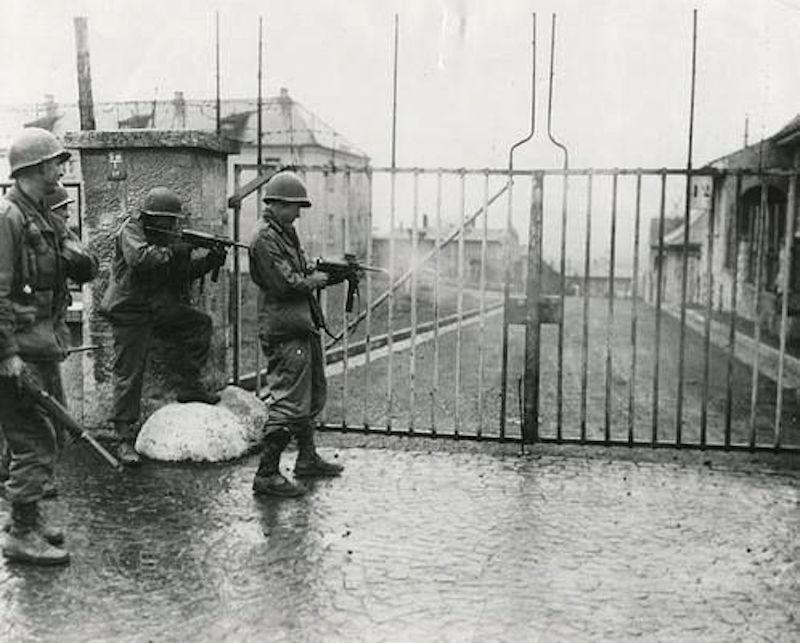Air Operations, CBI
BURMA- More than 70 10th Air Force fighter-bombers attack numerous targets across central Burma.
- 3 308th Heavy Bomb Group B-24s attack the Bakli Bay area.
- 8 14th Air Force P-51s attack rail targets of opportunity in the Yellow River area.
- 23 V Bomber Command B-24s attack port facilities and oil stores at Yulin, Hainan.
- 24 345th Medium Bomb Group B-25s attack a Japanese destroyer and 2 frigates off Amoy. All 3 warships are sunk against the loss of 2 B-25s.
Air Operations, Europe
RAF BOMBER COMMANDDaylight Ops:
- 54 Lancasters and 1 Mosquito of No. 5 Group are sent to attack a ship or ships which had broken the naval blockade around that large part of western Holland where German forces have been cut off. The raid is abandoned because of bad weather.
GERMANY:
- 215 1st Air Division B-17s and 106 3rd Air Division B-17s attack the main rail station at Leipzig (secondary).
- 183 2nd Air Division B-24s attacl a marshalling yard at Halle.
- 33 heavy bombers attack several targets of opportunigy.
- 4 B-17s and 1 of 630 VIII Fighter Command escorts are lost.
GERMANY:
- 99 9th Air Divisin bombers attack the city of Herzberg and marshalling yards at two other locations.
ITALY:
- 12th Air Force B-25s are diverted by bad weather from attacking rail lines in the Brenner Pass area, but they are able to attack gun emplacements at La Spezia and six bridges in the Po River valley.
- XXII TAC P-47s support the US 5th Army and attack lines of communication in the Po River valley.
- During the night, XXII TAC A-20s ant A-26s attack several crossing points in the Po River valley and bridges at four locations.
ITALY:
- 387 15th Air Force heavy bombers attack flak emplacements and an ordnance depot at Verona, and a marshalling yard and small-arms factory at Brescia.
Air Operations, Formosa
38th Medium Bomb Group B-25s attack Hokko.
[Air Operations, Japan
- 8 28th Composite Bomb Group B-24s attack the Kurabu Cape airfield and nearby targets.
- 8 B-25s armed with napalm bombs attack radar stations at 3 locations in the Kurile Islands.
Air Operations, Pacific
In Operation KILUSUI (FLOATING CHRYSANTHEMUM) the first of 10 massed kamikaze attacks on the US invasion fleet off Okinawa takes place. The last will take place June 21.
[Air Operations, Philippines
- FEAF B-24s attack Jolo Island and Cebu.
- 494th Heavy Bomb Group B-24s and 42nd Medium Bomb Group B-25s attack Bunawan.
- V Bomber Command A-20s support US 8th Army ground forces on Negros.
- V Fighter Command fighter-bombers attack Carabao Island and Infanta, and support US 6th Army ground forces on Luzon.
Air Operations, Rykyus
- As the weather clears, USN carrier aircraft support U.S. Tenth Army ground forces on Okinawa and intensify preinvasion strikes against Ie Shima.
- The Japanese, who have amassed 303 kamikazes and approximately 430 other aircraft within range of Okinawa, inaugurate Operation TEN-GO. More than 400 Japanese aircraft based in Japan take part in an all-out one-day effort against the Okinawa invasion fleet. While many attackers are kamikaze aircraft, the majority are escorts or bombers launched with intention of returning to their bases. The 22 kamikazes that manage to penetrate the fighter umbrella and anti-aircraft barrage each strike a different ship, of which 2 radar picket destroyers, a minesweeper, 2 ammunition ships, and an LST are sunk or mortally damaged. 10 other vessels are severely damaged, and others, including the fleet carrier USS Belleau Wood, suffer lesser damage in the attacks. An estimated 300 Japanese planes are expended or downed.
- All Task Force 58 ground-support operations are terminated for the day, and all fast-carrier light bombers are struck below to make way for intense fighter operations. As a result, US Navy carrier-based F6Fs, F4Us, and FMs down 257 Japanese aircraft over the northern Ryukyus between 0600 and 2015 hours and US Marine Corps carrier-based aircraft down 2 Ki-46 'Dinah' reconnaissance planes, 4 B6N 'Jill' torpedo bomber, and 12 fighters between Okinawa and Kyushu between 0845 and 1630 hours.
Air Operations, Western Pacific
24 345th Medium Bomb Group B-25s sink a Japanese destroyer and 2 frigates sailing from Canton to Japan. 2 B-25s are lost.
[Battle of the Atlantic
U-1195 torpedoes and sinks the British transport Cuba from Convoy VWP-17. After screening the convoy into Portsmouth, the escorting ships returned to look for the culprit. The British frigate Monnow delivered a Hedgehog attack which resulted in the sinking of U-1195.
| Class | Type VIIC/41 |
| CO | Kapitänleutnant Ernst Cordes |
| Location | English Channel |
| Cause | Hedgehog |
| Casualties | 31 |
| Survivors | 18 |
Eastern Front
The battle of Vienna begins. The Germans blow up all the bridges across the Danube except one. The German 2nd Panzer Army and 6th SS Panzer Army manage to drive back the Russian forces in the Wiener Wald and counterattack northwest toward Klosterneuburg. The Russian 46th Army outflanks Vienna from the south. Gen Lothar Rendulic takes over command of the German Army Group South (600,000 men) from Gen Otto Wöhler.
Army Group Center renews its attacks against the 4th and 2nd Ukraine Fronts in Czechoslovakia. Breslau still holds out against the Russians.
In the Danzig area the Russians break through the German 2nd Army's line in several places. In East Prussia after several days of preparatory bombardment and air raids, the 2nd Belorussian Front opens the major attack against Königsberg and penetrates into the city.
Yugoslavian forces expel the Germans from Sarajevo.
EAST PRUSSIAThe offensive against Königsberg begins, the 3rd Belorussian Front deploying 138,000 troops against the 35,000 of the garrison. Overhead, the Soviet 1st and 15th Air Armies pound the city as the Soviets break into the suburbs.
AUSTRIAThe defense of Vienna begins as the 2nd and 3rd Belorussian Fronts launch their offensive. Defended doggedly by the 6th SS Panzer Army, the 4th Guards and 6th Guards Tank Armies suffer heavy casualties as they attack.[MORE]
[Italy
The US 92nd Div continues its offensive against Massa. The British 56th Div moves in force across the Reno River.
[Occupied Yugoslavia
Sarajevo is liberated.
[Okinawa
The 6th Marine Div makes little progress northward in the Isthmus of Ishikawa. There is intense fighting in the southern sector, where the formidable Japanese Shuri line withstands all attacks.
At first light, aircraft from the US 5th Fleet attack Kyushu Island to prevent the planned Japanese attack by suicide aircraft on the US naval forces assembled off Okinawa. Some dozens of aircraft are destroyed, but the Japanese still manage to send about 400 aircraft against the Okinawa invasion fleet; three-quarters of which are destroyed. 24 of them, however, actually hit targets and they sink 2 destroyers, the Bush (DD-529) and the Calhoun (DD-801), 1 tank landing craft LST-447 and 1 fast minesweeper Emmons (DMS-22) and damage the light aircraft carrier San Jacinto (CVL-30), the British aircraft carrier Illustrious, 11 destroyers including Morris (DD-417), Bennett (DD-473), Hutchins (DD-476), Leutze (DD-481), Mullany (DD-528), Harrison (DD-573), Newcomb (DD-586), Howarth (DD-592), Haynesworth (DD-700), Hyman (DD-732), and Taussig (DD-746), the destroyer escorts Witter (DE-636) and Fieberling (DE-640), the high-speed minesweeper Rodman (DMS-21), the minesweepers Facility (AM-233), Ransom (AM-283), Defense (AM-317) and Devastator (AM-318), and the motor minesweepers YMS-311 and YMS-321. The furious fighting also results in many US ships hitting each other. The battleship North Carolina (BB-55), the cruiser Pasadena (CL-65), the attack transport Barnett (APA-5), the attack cargo ship Leo (AKA-60), the sub-chaser PCS-1390, and the landing craft LST-241 and LST-1000 are all damaged by friendly fire.
At 4:00p.m. the Japanese 2nd Fleet sails from Tokuyama Bay, in Honshu Island, heading for Okinawa.
[Pacific
- US Army aircraft sink the Japanese destroyer Amatsukaze and the coast defense vessels Nos. 1 and 134 off the coast of China.
- The Japanese minesweeper No. 12 is sunk by the US submarine Besugo (SS-321) in the Netherlands East Indies area.
- The US submarine Hardhead (SS-365) attacks a Japanese convoy in the Gulf of Siam and sinks the merchant cargo ship Araosan Maru (6886t).
- Mines sink several Japanese ships: merchant cargo ships Eoun Maru and Hsing Yun Maru (3414t) near Chunkiang; merchant cargo ship Fushimi Maru (1229t) in Shimonoseki Strait.
Philippines
On Luzon the 158th Regimental Combat Group, landed at Legaspi and held up by the Japanese in their advance north, extend their control in the south at the narrowest point of the Bicol peninsula. In the US I Corps sector, a regiment of the 32nd Div captures a hill in the Salacsac Pass area and advances on Kapintalan. In the XI Corps sector, the assault is launched on Mount Mataba, with a maneuver to approach Mount Oro and Mount Pacawagan.
[Western Front
In the US 9th Army sector, The 84th Inf and 2nd Arm Divs of the XIII Corps open the offensive across the Weser. Units of the XIX Corps cross the Weser near Grohnde and then advance on Burgstemmen.
The XVIII Airborne Corps, US 1st Army, opens an offensive against the Ruhr pocket near the confluence of the Rur and Rhine Rivers. While the VII Corps approaches the Weser, the V reaches the river and secures a bridgehead over it.
Elements of the French II Corps, French 1st Army, reach the Neckar in the neighborhood of Lauffen, the Enz River at Mühlacker and the outskirts of Pforzheim, and take Stein and Königsbach.
The German POW camp at Hammelburg is liberated, but all the prisoners except the seriously wounded had been evacuated.
[Images from April 6, 1945
|
|
|
|
|
|
|
|
